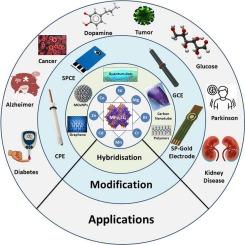用于电化学传感的先进铁氧体杂化纳米结构:生物医学诊断应用综述
IF 4.9
2区 化学
Q1 CHEMISTRY, ANALYTICAL
引用次数: 0
摘要
铁氧体杂化结构是一类磁性金属氧化物,通常用分子式MFe₂O₄表示。M通常指二价金属离子,包括Mn、Fe、Co、Ni、Cu或Zn。混合纳米结构具有高导电性和大表面积,为电化学传感器提供了更灵敏、更可靠的传感。杂化铁的物理和化学性质因合成方法和加工条件的不同而不同。近年来,铁杂化材料因其催化和磁性而成为研究的前沿,并因其能够提高所开发传感器的选择性和灵敏度而受到广泛青睐。本文对铁杂化纳米传感器在癌症、神经退行性疾病、肾脏疾病和糖尿病等疾病诊断中的应用进行了综述。在这些标题下,研究了与铁氧体形成杂化结构的金属,回顾了这些结构的合成,并研究了它们在电化学诊断中的首选原因,并在表格中进行了组织。本文章由计算机程序翻译,如有差异,请以英文原文为准。

Advanced ferrite hybrid nanostructures for electrochemical sensing: a review of biomedical diagnostic applications
Ferrite hybrid structures are compounds classified as magnetic metal oxides, often denoted by the formula MFe₂O₄. M usually refers to divalent metal ions, including Mn, Fe, Co, Ni, Cu or Zn. Hybrid nanostructures provide both high conductivity and large surface area, offering more sensitive and reliable sensing in electrochemical sensors. The physical and chemical properties of ferrihybrids vary depending on synthesis methods and processing conditions. Recently, ferrihybrid materials have come to the forefront with their catalytic and magnetic properties and are widely preferred for their ability to increase the selectivity and sensitivity of the developed sensor. The application of ferri-hybrid nanosensors in diagnostics is examined in this comprehensive review under four main headings: cancer, neurodegenerative, renal and diabetes mellitus diseases. Under these headings, metals that form a hybrid structure with ferrite are examined, the synthesis of these structures is reviewed and the reasons for their preference in electrochemical diagnosis are investigated and organized in tables.
求助全文
通过发布文献求助,成功后即可免费获取论文全文。
去求助
来源期刊

Microchemical Journal
化学-分析化学
CiteScore
8.70
自引率
8.30%
发文量
1131
审稿时长
1.9 months
期刊介绍:
The Microchemical Journal is a peer reviewed journal devoted to all aspects and phases of analytical chemistry and chemical analysis. The Microchemical Journal publishes articles which are at the forefront of modern analytical chemistry and cover innovations in the techniques to the finest possible limits. This includes fundamental aspects, instrumentation, new developments, innovative and novel methods and applications including environmental and clinical field.
Traditional classical analytical methods such as spectrophotometry and titrimetry as well as established instrumentation methods such as flame and graphite furnace atomic absorption spectrometry, gas chromatography, and modified glassy or carbon electrode electrochemical methods will be considered, provided they show significant improvements and novelty compared to the established methods.
 求助内容:
求助内容: 应助结果提醒方式:
应助结果提醒方式:


